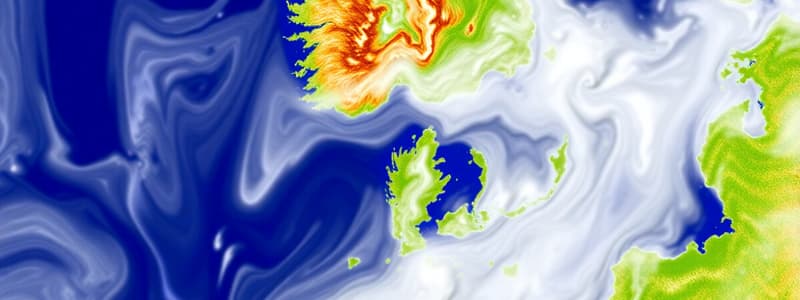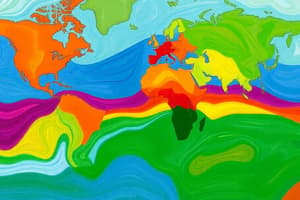Podcast
Questions and Answers
Which characteristic primarily defines Group C climates, often found in regions like the central U.S. and southern Europe?
Which characteristic primarily defines Group C climates, often found in regions like the central U.S. and southern Europe?
- Severe winters with short, cool summers.
- Mild winters and noticeable seasonal changes. (correct)
- Extremely dry conditions with minimal seasonal variation.
- Consistent high temperatures and heavy rainfall throughout the year.
How do Group D climates differ primarily from Group C climates in terms of winter conditions?
How do Group D climates differ primarily from Group C climates in terms of winter conditions?
- Group D climates alternate between mild and severe winters unpredictably, unlike Group C.
- Group D climates experience milder, shorter winters compared to Group C.
- Group D climates have virtually no winter season, unlike Group C.
- Group D climates have severe and prolonged winters, distinguishing them from Group C's mild winters. (correct)
Which factor is most crucial in determining the sub-classification within the major climate groups?
Which factor is most crucial in determining the sub-classification within the major climate groups?
- Specific temperature ranges and rainfall amounts throughout the year. (correct)
- The presence of specific types of vegetation.
- The average wind speed during the summer months.
- The proximity to large bodies of water.
If a region is classified as Group E, what can be generally inferred about its temperature patterns throughout the year?
If a region is classified as Group E, what can be generally inferred about its temperature patterns throughout the year?
How do Group A and Group E climates compare to each other regarding seasonal changes?
How do Group A and Group E climates compare to each other regarding seasonal changes?
What is the key distinction between 'weather' and 'climate' as described in the text?
What is the key distinction between 'weather' and 'climate' as described in the text?
In the Köppen climate classification system, what primary factor did Wladimir Köppen use to categorize different climate zones?
In the Köppen climate classification system, what primary factor did Wladimir Köppen use to categorize different climate zones?
A region classified as 'Group A' under the Köppen system is most likely to exhibit which set of characteristics?
A region classified as 'Group A' under the Köppen system is most likely to exhibit which set of characteristics?
If a location is described as belonging to 'Group B' climate classification, what is the most probable environmental condition to be expected?
If a location is described as belonging to 'Group B' climate classification, what is the most probable environmental condition to be expected?
How does a 'Group C' climate, as per the Köppen classification, differ fundamentally from both 'Group A' and 'Group B' climates?
How does a 'Group C' climate, as per the Köppen classification, differ fundamentally from both 'Group A' and 'Group B' climates?
Flashcards
Climate
Climate
The long-term patterns of meteorological conditions in an area, including temperature, humidity, air pressure, wind, and precipitation.
Köppen Climate Classification
Köppen Climate Classification
A system that categorizes Earth's climates into five major groups based on native vegetation.
Group A: Humid Tropical
Group A: Humid Tropical
Warm, wet climate found along the equator, characterized by consistent warm temperatures and rainforests.
Group B: Dry
Group B: Dry
Signup and view all the flashcards
Group C: Humid Middle Latitude with Mild Winters
Group C: Humid Middle Latitude with Mild Winters
Signup and view all the flashcards
Humid Middle Latitude with Mild Winters
Humid Middle Latitude with Mild Winters
Signup and view all the flashcards
Humid Middle Latitude with Severe Winters
Humid Middle Latitude with Severe Winters
Signup and view all the flashcards
Polar Climate Region
Polar Climate Region
Signup and view all the flashcards
Major Climate Classifications
Major Climate Classifications
Signup and view all the flashcards
Climate Sub-Classifications
Climate Sub-Classifications
Signup and view all the flashcards
Study Notes
- Climate represents the overall pattern of meteorological conditions in a specific area, including temperature, humidity, air pressure, wind, and precipitation.
- Climate is essentially the long-term weather patterns of a region.
- The Köppen Climate Classification system, developed by Wladimir Köppen in 1884, categorizes Earth's climates into five major groups based on native vegetation.
- Köppen used plants as the basis for his classification, regarding them as the best indicators of local temperature, precipitation, and other climate-related variables.
Earth's Five Major Climates
- The classifications start at the equator and move outward toward the Polar Regions, labeled with letters A to E.
- Group A, or 'humid tropical,' is located along the equator and is characterized by warm, wet conditions year-round, similar to summer, and includes rainforests like the Amazon.
- Group B, the 'dry' group, is found just north and south of the equator and is defined by low moisture and includes deserts like the Sahara and Great Victoria; temperatures remain fairly constant throughout the year in this region.
- Group C, the 'humid middle latitude with mild winters' region, is located further from the equator and experiences seasonal changes with tolerable winters; it is found in areas like the central U.S., southern Europe, and central South America.
- Group D, the 'humid middle latitude with severe winters' region, is closer to the poles and has much colder winters than Group C; examples include northern Canada and Siberia.
- Group E, the polar group, is located at the Arctic and Antarctic regions and is characterized by year-round cold conditions with no seasonal change.
- Each of the five major climate groups can be further divided into more specific classifications based on temperature ranges and rainfall amounts, with a total of 14 sub-classifications.
Studying That Suits You
Use AI to generate personalized quizzes and flashcards to suit your learning preferences.
Description
Climate is the long-term pattern of meteorological conditions, including temperature and precipitation. The Köppen Climate Classification system categorizes Earth's climates into five major groups based on native vegetation. These classifications range from humid tropical regions to dry areas.





